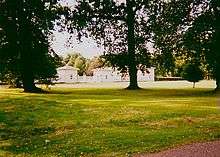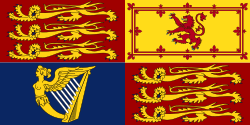Royal Lodge
The Royal Lodge is a Grade II listed house in Windsor Great Park in Berkshire, England, half a mile north of Cumberland Lodge and 3.2 miles (5.1 km) south of Windsor Castle.[1] It was the Windsor residence of Queen Elizabeth The Queen Mother from 1952 until her death in 2002. Since 2004, it has been the official country residence of Prince Andrew, Duke of York and ex wife, Sarah, Duchess of York

History

The Lodge dates originally from the mid-seventeenth century, there being a house on the site by 1662. By 1750, the small Queen Anne style brick house was being used in conjunction with the adjacent dairy. By this time, it was known variously as the Lower Lodge, to distinguish it from Cumberland Lodge, then known as the Great Lodge, or the Dairy Lodge.
From the mid-eighteenth century, it was home to the military topographer and artist Thomas Sandby (brother of the better known Paul), as Deputy Ranger of the Great Park. The house was then known as the Deputy Ranger's House.
It was enlarged by 1792 and was the home of Joseph Frost, the Park Bailiff, and then of the General Superintendent of Farms, after Sandby's death.
George, Prince of Wales (later King George IV), planned to rebuild Cumberland Lodge, after he had become Prince Regent. He used the Lower Lodge as temporary accommodation in 1812. Alterations and additions were undertaken by John Nash[2] for the Prince of Wales.
The chapels of the Royal and Cumberland Lodges proved too small for the royal households in the early 19th century, and the Royal Chapel of All Saints was built in 1825 by Jeffry Wyatville. The chapel is less than a hundred yards from Royal Lodge.
It was now a large and elaborate cottage in the contemporary style of the cottage orné, with thatched roofs, verandas, and a conservatory. It became known as the Prince Regent's Cottage after the prince moved into it in 1815. The renovation of Cumberland Lodge was abandoned.
Additions were made after 1820. In 1823, Jeffry Wyatt (later Sir Jeffry Wyatville) succeeded Nash as architect, and the house (known now as the "King's Cottage") became known as the Royal Lodge in the late 1820s.
After 1830, King William IV ordered the demolition of all of the house, except the conservatory. It became a residence again in 1840, and was used as accommodation for various officers of the Royal Household until 1843, and from 1873 to 1931.
The grounds extend to 98 acres (40 hectares),[3] partly under its own head gardener, but mostly the responsibility of the Crown Estates Commissioners. While the house has grown piecemeal since the 1840s, and remains relatively small and informal, the grounds have a unifying plan. This was the result of work undertaken by the Duke and Duchess of York in the 1930s, with the assistance of Sir Eric Savill, of the Windsor Estate.
In 1931, King George V granted Royal Lodge to the Duke and Duchess of York (later King George VI and Queen Elizabeth) as a country retreat. Wings were added on each flank in the 1930s. There are two lodges at the entrance, and groups of three cottages each side of the lodges. The main building has some 30 rooms, including 7 bedrooms, and a saloon (48' by 30' by 30'). The original conservatory survives. The grounds contain the miniature cottage Y Bwthyn Bach, a gift to Princess Elizabeth as a child from the people of Wales in 1932.
After the death of George VI in 1952, The Queen Mother continued to use the house as one of her country retreats as a grace and favour residence, until her death. The Queen Mother died at the Royal Lodge in March 2002, with her daughter, Queen Elizabeth II, by her side.
Lease to Prince Andrew, Duke of York

In August 2003, The Duke of York was granted a lease agreement by the Crown Estate for 75 years. The property leased included the Royal Lodge, a Gardener's Cottage, the Chapel Lodge, six Lodge Cottages, and Police security accommodation in addition to 40 hectares of land. The lease agreement required Prince Andrew to carry out, at his own expense, extensive refurbishing work estimated at £7.5 million at September 2002 prices, excluding VAT (this sum was in fact exceeded). It also provided for a premium payment of £1 million. The National Audit Office (NAO) report into the lease agreement states that the Crown Estate's independent advisors had advised that the refurbishment work would cost at least £5 million and that the Prince should be given the option to buy out the notional annual rental payment (set at £260,000) for £2.5 million. Once the Prince committed to spending £7.5 million on refurbishment, it was decided that no rental would be required as he would be treated as having effectively bought out the notional annual rental payment because he exceeded the minimum £5 million required for refurbishment. As a result, only the £1 million premium was paid to the Crown Estate.[3] There is no provision for any further rent review over the life of the 75-year lease agreement (unlike the rent reviews provided in the case of Bagshot Park, residence of Prince Edward, Earl of Wessex, also leased from the Crown Estate).[3]
The lease agreement provides that the prince may not benefit financially from any increase in the value of the property as the freehold belongs to the Crown Estate. The leasehold may be assigned only to his widow or his two daughters, Princess Beatrice of York and Princess Eugenie of York (or a trust established solely for their benefit). This may be a significant benefit given the increase in the value of the property and the notional annual rental payment which it would command over the course of the 75-year lease. The NAO Report does not specify whether sub-leasing by the prince or his daughters is allowed under the rental agreement. If the prince terminates the lease, the property would revert to the Crown Estate. He would be entitled to compensation for the refurbishment costs incurred up to a maximum of just under £7 million, which is reduced annually over the first 25 years, after which no compensation is payable.[3]
The NAO report states that having already taken advice from one independent advisor on the transaction, the Crown Estate appointed a second firm of independent advisors to assess the details of the lease deal, given its importance. The second independent advisor concluded that the deal was appropriate having regard to the need to maintain management control over Royal Lodge and because of the security implications (particularly concerning the Royal Family's access to the Royal Chapel). In the circumstances, the Crown Estate considered that the requirement to obtain value for money was satisfied, taking into account the non-financial considerations relating to the lease of the property. The alternative use, to lease it on the commercial market, was therefore not possible.[3]
Following extensive renovations, Prince Andrew, Duke of York, with his two daughters, moved into the house in 2004, having vacated Sunninghill Park.[4] In 2008, Sarah, Duchess of York, joined the Duke and their daughters in the home.
References
- Historic England. "Royal Lodge (1323669)". National Heritage List for England. Retrieved 6 December 2013.
- page 175, John Nash A complete catalogue, Michael Mansbridge, 1991, Phaidon Press
- "The Crown Estate – Property Leases with the Royal Family". Report. National Audit Office (United Kingdom). 2005. Retrieved 19 April 2015.
- The fall of the house of York: Why has the mansion sold by Duke in mystery £15m deal gone to ruin? Daily Mail. 24 February 2009

.svg.png)